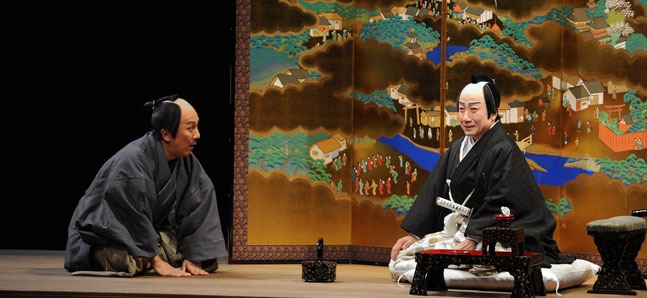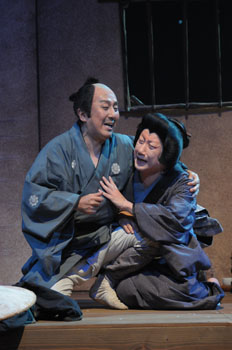This is Kabuki: Sakura Giminden
Rap beats set free the souls of Edo peasants into the streets of Shibuya

Photo: Sochiku Co.,Ltd.
Posted: Mon Jun 21 2010
Currently gracing the stage at Shibuya’s Bunkamura Theatre Cocoon is the 11th Shibuya Cocoon Kabuki Show, ‘Sakura Giminden’. On June 2, the day before the premier, members of the media were treated to a full dress rehearsal. Onstage was a mud pool, and as mud-streaked peasants were suffering under a heavy land tax and government corruption, in real life the now former prime minister, Yukio Hatoyama, was announcing his intention to resign. One cannot help but feel some comic coincidence between the deep-seated hatred of the struggling peasants of feudal times and Hatoyama who gave up his post with unfulfilled ambitions.
‘Sakura Giminden’ is set against the political and economic backdrop of the mid-seventeenth century in Sakura in Chiba prefecture. The play, ‘Higashiyama sakura no soshi’ is based on an historical event that took place 366 years ago, first premiered in the Nakaura-za theatre in 1851, to which it received resounding applause from the audience.
The peasants in the play’s Sakura village were required to hand over all of the rice they grew to the government as land tax, leaving them to eke out an existence by surviving on millet and other grains, which they made into a watery gruel. The poverty was so oppressive that parents were forced to sell off their daughters as slaves and many families turned to suicide – there was no end in sight. Village head, Sogo Kiuchi, (played by Kanzaburo Nakamura) decides that he has to do something to help the peasant’s plight. The village head is the go-between with the feudal lords and has the role of representing the village people, while at the same time collecting their land taxes. In other words, Sogo is in a difficult position caught between the government and the people.
When Kiuchi brings up the peasant’s dire circumstances with the feudal lord it falls on deaf ears. The feudal lord is only concerned about moving up the ladder and responds, ‘I just got promoted and that would cost money in one way or another.’ Kiuchi, having no other option, goes directly to the Shogun Iesuna. Directly approaching the shogun, according to the feudal system in the Edo period, was considered extremely disrespectful and as such, was a serious crime punishable by death. What happens thereafter in this performance of ‘Sakura Giminden’ is different to other versions – and to actual events – but we understand that people interpret things differently (which won’t be explored here). It is a fact, however, that Kiuchi was killed along with his family.
While each kabuki performance at Cocoon breaks its traditional framework and surprises the audience, likewise this performance shatters any preconceived ideas we may have about kabuki. Director Kazuyoshi Kushida says that the actors perform on top of a large mound of mud ‘in order to represent the living conditions of peasants.’ This means that the box seats have to be covered in plastic sheeting. The story is told through rap by a singer-songwriter on guitar. A hip hop beat is played on the Japanese drums to which the kabuki actors together with young actors (playing the role of peasants) rap with the rhyme ‘Hashire! Sogo! Hita hashire! Omoishire!’(‘Run! Sogo! Get the hell outta here! Get while the gettin’s good!’)

Photo: Sochiku Co.,Ltd.
While some will probably question whether or not this can be considered kabuki, Senjaku Nakamura, who plays the role of both Sogo’s wife and the feudal lord (who are direct opposites in character) muses, ‘It’s by whittling away that which already exists that we can get at what kabuki really is. If you ask me this is kabuki. This is a play where people are “doing kabuki”. Because kabuki actors are people who “do kabuki” they do things that other people don’t, and do crazy things.
There are sure to be mixed reviews. On one hand there will probably be some people who hate it, and on the other hand there will be some people who want to see it again and again. The play might be seen as having an extremely political message with things like Seiko Ito’s rap, which raises the problem of the bases in Okinawa. At the end of the day it is a piece of entertainment so we aren’t really aiming to raise issues.
However, the growing resentment towards the shogun by the peasants was a kabuki theme 400 years ago when kabuki began, so in actually fact we could say that we are “returning to the origins of kabuki”. The overwhelming feeling I get from doing this performance is that the voice of the people never dies. It’s not so much about us acting out a feudal society but more about us gi ving testimony to the life force of the everyday person in feudal society who lived their lives with great strength.’
Peasants from 366 years ago are breaking new ground and appearing on the streets of Shibuya to the repetition of rhymes and the beat of the taiko drum. It seems as Nakamura said, the voice of the people never really does die.
Sakura Giminden
Date: Until Sun June 27
Location: Theatre Cocoon (Full details & map)
Director/Art director: Kazuyoshi Kushida
Performers: Kanzaburo Nakamura, Senjaku Nakamura, Hashinosuke Nakamura, Yajuro Bando, Shichinosuke Nsksmura, Kamezo Kataoka, Takashi Sasano
Tickets: ¥3,500-¥13,500
Same day tickets go on sale 60 minutes before curtain. Advance tickets can be bought at the Bunkamura Ticket Centre. Advance tickets can be reserved up to a day before performance.
Bunkamura Ticket Centre: (03)3477 9999 (10am-5.30pm)
Ticket Phone Shochiku: (0570)000 489 (10am-6pm)
Tweets
- About Us |
- Work for Time Out |
- Send us info |
- Advertising |
- Mobile edition |
- Terms & Conditions |
- Privacy policy |
- Contact Us
Copyright © 2014 Time Out Tokyo














Add your comment